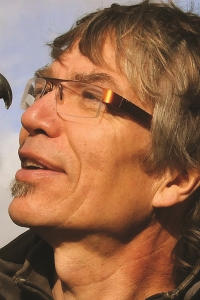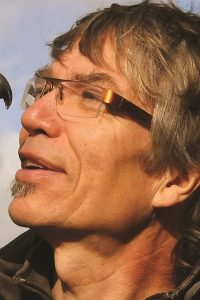Home » News » Blog » LGA 2017 – Peter Powning
LGA 2017 – Peter Powning

The Lieutenant-Governor’s Awards for High Achievement in the Arts recognize and celebrate outstanding New Brunswick artists and writers who have distinguished themselves by the excellence of their achievements and their contribution to the arts in the province.
Peter Powning, laureate of the 2017 Lieutenant-Governor’s Award for High Achievement in Visual Arts, answers a few questions about his life and art practice.
- Tell us about your upbringing, where you grew up, etc.
It really wasn’t anything special, at least it didn’t seem that way. My mother majored in art at university for 2 years until she switched to a teaching degree for practical reasons. I think as a result of her interests and my Dad being a guy who made things (furniture, looms, photographs) that I probably was imbued with the idea that art was interesting. They took me to galleries and museums so I had a haphazard exposure to visual art. I was encouraged by my parents in artistic pursuits.
- Was there an inspiring moment in your youth that influenced your choice of career?
I don’t think there was one Eureka moment. Just a gradual dawning that it was possible. When I was in university I did meet an established ceramist who showed slides of his work and home life and that gave me the idea that I could actually make a living doing what I loved doing.
- When did you start your practice? Were there particular challenges that you faced? What important lessons have you learned?
I started my own studio practice in 1972 in a grain shed on the same place I live now. It was a very shoestring operation but was enough for me to make and sell ceramics as a full time occupation. It was a family business right from the beginning. When that studio burned down there was enough insurance for us to build a bigger, better studio with the volunteer help of many friends and used timbers from a derelict barn on our property. That building is now my bronze foundry.
The challenge is to keep reinventing myself. In my career I started out as a potter and gradually began making work in many materials, on many different scales. I’ve made mugs to major public art commissions during my career. I work in slumped glass, cast bronze, stainless steel, stone, pigmented concrete, photographic print processes and found materials.
- What is your art practice about? Tell us more about your creative process.
Producing art from a rural base presents many opportunities and challenges. One would think the benefits might include the space and time to be reflective and unpressured. There are times when this is so. However, recognition of his work has come at the cost of at least some of that tranquility. Intrusions from the world beyond the edges of our quiet little corner of rural Canada are legion and, sadly, mostly self-induced. This bargain I’ve struck with ‘busyness’ relates to business: the business of making art for a living. Like many of us, I feel too busy. Our culture is caught up in the imagined virtue of being very busy, I’m afraid I haven’t entirely evaded that mania.
Yet paradoxically, or maybe as a result of this feeling, much of my work is about tranquility or a reflection on the search for it. Sometimes my sculpture is an attempt to give form to an emotion. Sometimes my work is meant to give a sense of being from another time, a cultural artifact from a distant future/past. The surfaces I produce are usually aged and worn. This is partly to imbue each piece with an aura of mystery and depth, the look of something discovered or dug up, like a museum specimen from an archaeological dig. For me, making art is an archaeological dig. I burrow through the overburden in my head for shards of form and meaning, I mine collections of stones, bones and other found objects for correlations. I walk the woods and shores of the region soaking up their essence. In real materials, I experiment with what flows from my observations to see what can be discovered and what might be revealed. It’s a long evolving process. I take diverse, often fragmented elements and attempt to unify them into something approaching whole.
- How important is public engagement for you and your work?
My public art is very much about public engagement. It’s really a different discipline than studio work made on spec for gallery exhibitions. Public work has to have ways for the general public to engage with it.
- What would you tell today’s emerging artists?
Persevere, take risks, learn from mistakes, network, travel, be open to new ideas, read and try to see the world without filters.
 Since 1970, Peter Powning has lived and worked as an artist in the hills of southern New Brunswick. While Powning’s award-winning work is shown internationally, it is imbued with qualities distilled from a life lived close to the silence, space and seasonal rhythms of his home and of the fields, forests and shorelines of Canada’s east coast.
Since 1970, Peter Powning has lived and worked as an artist in the hills of southern New Brunswick. While Powning’s award-winning work is shown internationally, it is imbued with qualities distilled from a life lived close to the silence, space and seasonal rhythms of his home and of the fields, forests and shorelines of Canada’s east coast.
Known as an inveterate experimenter and risk-taker, he works in a wide range of media, often combining glass, cast bronze, stone, ceramics and steel. In addition, he produces large photographic prints of ephemeral works and is engaged in large public commissions. Powning has been awarded the Governor General’s Bronfman Award as well as an honorary doctorate from the University of New Brunswick.


 Since 1970, Peter Powning has lived and worked as an artist in the hills of southern New Brunswick. While Powning’s award-winning work is shown internationally, it is imbued with qualities distilled from a life lived close to the silence, space and seasonal rhythms of his home and of the fields, forests and shorelines of Canada’s east coast.
Since 1970, Peter Powning has lived and worked as an artist in the hills of southern New Brunswick. While Powning’s award-winning work is shown internationally, it is imbued with qualities distilled from a life lived close to the silence, space and seasonal rhythms of his home and of the fields, forests and shorelines of Canada’s east coast.